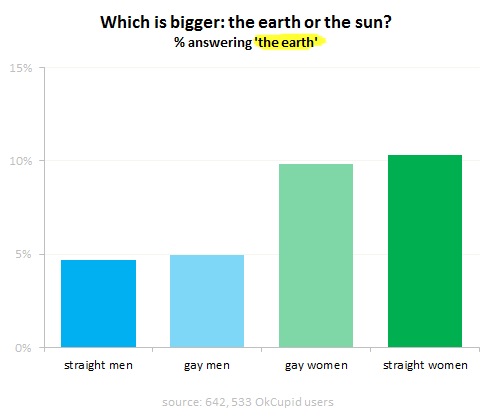I’ve been using the p-prim ever since I’ve learned of them, back in my graduate school days at UC Berkeley. P-prims stand for phenomenological primitives and were “invented” by Andrea diSeesa, a UC Berkeley professor in the School of Education who also happens to be a physicist (diSessa, 1983). Visit his Wikipedia page and check out some of the cool projects he’s working at now.
Before I give a definition of a p-prim, I think it would be good to give a few examples. Here’s a graph published by OkTrends on beliefs of various groups (in this case as defined by their sexual orientation) about the relative size of our sun versus the Earth (our planet).
Even disregarding the differences in percentages due to sexual preference, an awesome 5 % to 10 % of our population believes that the planet we live on is larger than the star it orbits.
Would this qualify as a p-prim? Yes:
- it’s not a formally learned concept;
- it describes a phenomenon;
- it’s a bit of knowledge based on personal observations: the sun looks like a small round disk in the sky;
- it’s a useful problem-solving tool when one has to draw a picture with the earth and sun (the sun looks small in most drawings and photos);
- when a person who states this p-prim is asked to elaborate, the following conversation would be full of slippery thoughts and hard to explain ideas—these individuals just haven’t given this much thought.
So the sun is smaller than the earth p-prim is useful in some circumstances and is collected through everyday experience of living in our world. This p-prim is not some grand idea; it doesn’t constitute some big theory of how things work; it’s just a tiny problem-solving tool that’s good in a tiny subset of circumstances. Individuals that hold this p-prim might hold others that are completely contradictory like stars are bigger than planets—they sure do look that way in SciFi shows and movies.

Here’s another example: the water heated on the stove will continue to get hotter and hotter the longer it stays on top of the burner. Based on this p-prim, one will get a resounding YES to the following question: “Is the water that had been boiling in a pot for 10 minutes hotter than the water that just came to a boil?” It’s been heating longer, so of course it hotter! It’s true based on other everyday observations like metal pots on the stove—pots get hotter and hotter over time. (I know this isn’t true, but bear with me.) Can the pot get hotter than the heat source? You betcha! And we have another p-prim!
The most common and widely used p-prim that I’ve discovered is the more is better: more money is better, bigger house is better, bigger car is great (or car with a bigger milage). More, more, more! This is one of the most common problem solving shortcuts in our culture. If you look at the two examples of heat-related p-prims, you would notice that somewhere in them there’s the notion of more is better: more gets bigger results.
Some what are p-prims and what are the used for? One useful way to think of them is as a cognitive shortcut to problem solving. A quick glance at a stove, and you know that pot that’s been sitting there is hot. How hot? How long has it been sitting there? American Test Kitchen (a TV show and a magazine) recommend leaving a pot on the stove for almost 5 minutes before starting to fry a steak—that’s hot!
P-prims are not the only cognitive shortcut tools. Pattern matching and category formation work well, too. But if I had to put my money down, p-prims are likely the fastest…but perhaps, less reliable than the other two methods of reasoning. So it’s probably a good time to give them a definition. In the words of Andrea diSessa: “P-prims are relatively minimal abstractions of simple common phenomena. … [Novices] have a large collection of these in terms of which they see the world and to which they appeal as self-contained explanations for what they see.” (diSessa, 1983) This is the intuitive background knowledge that is hard-to-access and not-easily-put-int-words—the slippery thoughts, as I call them.
A particular individual would have a large collection of p-prims from which causal inferences can be made about a situation (for problem solving purposes). Such collection of p-prims would not be internally consistent—it would all depend on aspects of the problem solving situation. Some explanations would “come to mind” under one set of circumstances and other explanations would be invoked by different situations. The same individual can generate contradictory explanations of the phenomenon under different circumstances—like the relative sizes of the sun, the earth, and the moon. It’s all about context.
These properties of p-prims can be summarized by two attributes:
- Cuing Priority—how likely the idea (a p-prim) is to be profitable.
- Reliability Priority—how resistant the idea (a p-prim) is to change.
If a particular p-prim is useful in generating explanations across many situations, then it has a high cuing priority—it “comes to mind” a lot. A p-prim that has “served” an individual well would be difficult to modify and would have a high reliability priority.
P-prims and Academia
P-prim is a funky sounding name, wouldn’t there be other, equally good ways of calling this concept, you’d ask? Well, sure. It’s been my experience that ideas get invented over and over again: give it a different name, publish, get press, get recognition, etc. I find that at most conferences presenters give talks on topics I’ve studied years ago as something new and exciting: if it was published before the age of the Internet, it might as well not have been published at all! And so there are many different names for p-prims. I’ll list a few here with appropriate references, but I’m sure that there are many others out there that sound different but describe the same idea. Personally, I like p-prims (although folky wisdoms would do in a pinch).
- p-prims: Andrea diSessa’s phenomenological primitives (see more here)
- folksy wisdoms: intuitive beliefs held by a particular population (think small sub-cultures) that generate explanations to observable events (see more here)
- facets: convenient units of thought, pieces of knowledge, or strategies seemingly used by individuals in addressing a particular situation (Minstrell, 1992)
- primitive beliefs & exaggerated resistance: “Adults may resist scientific facts because of childhood experiences. Yale University psychologists note that before children can even speak, they develop common-sense assumptions about the physical world that can persist into adulthood and clash with scientific discoveries.” (Choi, 2007) This is a study on how early life experiences with reality (and physics) can prejudice comprehension of scientific phenomena in adults. It struck me as similar to ideas diSessa was working on over 20 years prior! Their note on “trustworthy sources of authority” is very much in line with my own master’s theses about authority p-prims. (Werby, 1993)
- knowledge chunks: small pieces of background knowledge that capture individual’s naive comprehension of some idea.
Rain Dancing
This might a good place to introduce another source of p-prims: superstitions!
- p-prim: dancing results in changing the weather
- Cuing Priority: comes to mind when there hasn’t been rain for a while, usually around October or November in California
- Reliability Priority: around October or November, California weather is likely to change and bring rain—if the dancing goes on long enough, it will sure to rain
Product Design Implications
As previously discussed on this blog, users of products come with a full baggage of assorted cognitive traits. The job of the product designer is to figure a relevant subset of those that impact the design of the product. P-prims are just one of the things we look at when we try to anticipate ways in which our users might fail while using our product. Once we know what they are, we can design support structures to prop-up the users to the desirable level of performance (as defined by our business goals).
Bibliography
Choi, C. Q. (2007). “Roots of Science Hatred.” Scientific American: 297, 29 (2007) doi:10.1038/scientificamerican0807-29a [http://www.lifeethics.org/www.lifeethics.org/labels/technology.html]
diSessa, A. A. (1983). “Phenomenology and the Evolution of Intuition.” In D. Genter & A. L. Stevens (Eds.), Mental Models, pp. 15-33. Hillsdale, NJ: Lawrence Erlbaum Associates.
Minstrell, J. (1992). “Facets of students’ knowledge and relevant instruction.” In Duit, R., Goldberg,
F., and Niedderer, H. (eds.), Research in Physics Learning: Theoretical Issues and Empirical Studies. Kiel, Germany: Kiel University, Institute for Science Education.
Werby, O. (1993). “What Kids Know About Research.” Master’s Thesis, University of California at Berkeley.



P-Prims and Linguistics
As I was writing the post above, it struck me how similar some of the ideas around p-prim formation and reinforcement were to some of the mechanisms of language evolution. In particular, “overgeneralization”, “metaphor formation”, and “exaggeration” seem very relevant.
Overgeneralization is a mechanism by which new words are formed by applying a standard rule to a non-standard situation. “Goed” instead of “went” is an example of overgeneralization—using a standard rule of past tense formation on an irregular verb. Overgeneralizations are ways of looking for order, seeking patterns.
Apply this overgeneralization to a p-prim, and we get p-prims used in circumstances beyond their original scope: “friction slows things down” p-prim applied to rotating wheels—at some point, too little friction results in loss of traction.
Metaphor formation describes an invention of new words by using known words in a novel way to emphasize an idea. Our anger can reach a “boiling point,” we feel “bitter” hatred, and we “press on” to the end. Our economy “sinks” giving us “food for thought.”
Apply metaphor formation to a p-prim and we get the good old “more is better” p-prim used far and wide, from physics to civics.
Exaggerations allow us to communicate our emotions in a more “powerful” manner. When a simple “no” won’t do, we can add a few words to it to communicate that we really mean it: “no way no how”, “not in a billion years”, “hella no”.
Apply exaggerations to p-prims, and we get our intuitive understandings stretched to edge-case scenarios: what is stronger gravity or magnets?
These are not fully-worked out ideas, but there’s something interesting in here.
“A survey by Consumer Reports finds that more than half of Americans will skip the flu shot this year.
The top reason for skipping the vaccine was “the mistaken belief that it’s best to build one’s own natural immunities,” according to Consumer Reports.
It’s not only the lay people spurning the vaccine. The survey also points out that 28 percent who work in health care settings such as nursing homes and hospitals indicated they would definitely not get the vaccine.”
Source: http://pagingdrgupta.blogs.cnn.com/2010/10/28/bedbugs-attack-u-n-and-other-health-headlines/?hpt=Sbin
And we have another p-prim!